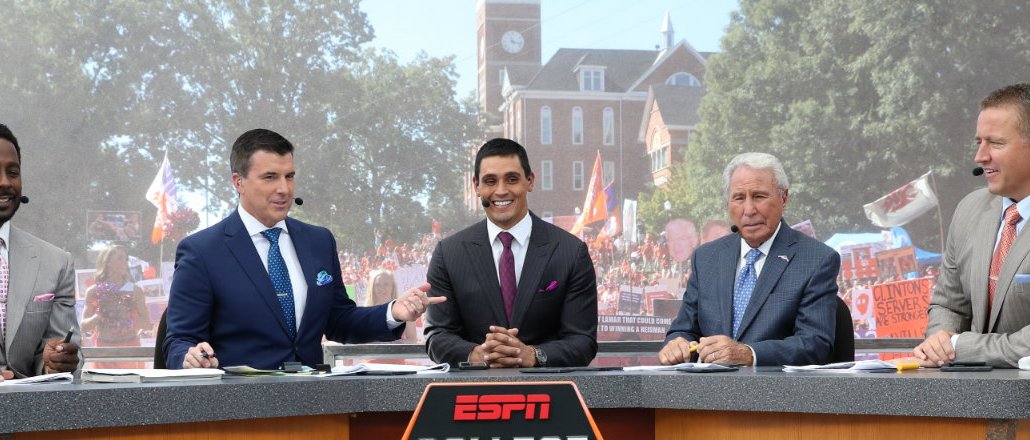
Since the start of the current college football season, ESPN has been producing an exclusive Snapchat Discover version of its weekly Saturday morning pregame show “College GameDay.” Like its TV counterpart, “College GameDay” on Snapchat is hosted by anchor Rece Davis and routinely features other on-camera talent including Lee Corso, Kirk Herbstreit, Desmond Howard and Samantha Ponder.
In addition to previewing that week’s primetime game and other marquee matchups, each episode is packed with segments ranging from behind-the-scenes tours of the host campus to player profiles and even highlights of the biggest moments from the previous weekend.
Each episode, running anywhere from two to four minutes, gets published to Snapchat Discover as a standalone tile at 6 a.m. ET every Saturday morning. This is in addition to ESPN’s daily magazine on Snapchat Discover, which the network has been a member of since the platform’s launch.
“Our Discover [channel] is awesome, but there are so many sports stories within each edition — you can get everything from coverage of the MLB playoffs to the start of the NBA season and wacky sports videos that might be trending on the internet that day,” said Steve Braband, director of social media content for ESPN. “What made [doing this show] attractive was that it gives us another chance to extend the GameDay brand beyond the TV show. We have to jump at those options in the ever-evolving digital space.”
ESPN has a team of six people handling “College GameDay” for Snapchat Discover. This includes producers on the ground at the host campus to shoot different features throughout the week. This week, for instance, the show will interview Wisconsin Badgers head coach Paul Chryst and players T.J. Watt, Robert Wheelwright and Sojourn Shelton. It will also feature a tour of the Badgers’ facilities and spotlight the school’s “Jump Around” tradition.
Show content produced on the ground, plus highlights and other video footage from ESPN broadcasts, gets clipped together by Friday night in ESPN’s Bristol headquarters.
While ESPN has six people devoted to the show, the team also gets constant feedback from the company’s 26-person social team, Braband said.
On-air talent is also getting pretty involved. “Rece Davis’ son has told him about the show, and he’s bought in, giving different takes and lines to use,” Braband said. “The talent works with us on the scripts and putting more of their personality into the segments.”
ESPN didn’t disclose what kind of viewership “GameDay” is getting on Discover, but Braband said it’s comparable to daily viewership for ESPN’s Discover channel. (The median Snapchat Discover channel was averaging 1 million daily viewers as of late June.)
Encouraged by the results, ESPN is very likely to do more original programming for Snapchat Discover, both for the “College GameDay” brand as it moves on to college basketball in the winter and other TV show franchises within the ESPN family.
“There are some great shows that could mesh with this platform,” Braband said. “SportsCenter, if you look across the other social platforms, is already big in the space. That’s probably next on the brainstorming whiteboard.”
The arrival of “College GameDay” on Discover coincides with Snapchat’s desire to have more high-quality video programming on the platform. As a result, multiple existing Discover publishers, including Bleacher Report and MTV, have started to roll out their own shows.
ESPN is not getting paid by Snapchat to do the “GameDay” show, Braband said, but it was encouraged by the Snapchat to create the show.
The decision was also influenced by the fact that social platforms now make it nearly impossible for TV shows to remain TV shows.
“We need social media to be a big part of the show — not just as a second island that’s used to share some links,” Braband said. “The show’s producers, staff and talent have bought in.”
Image: Allen Kee/ESPN Images
More in Media

Media Briefing: The top trends in the media industry for 2025
This week’s Media Briefing takes a look at the top trends from 2025, from digital advertising revenue performance to AI licensing deals.

Digiday Scorecard: Publishers rate Big Tech’s AI licensing deals
Digiday has compiled a scorecard grading AI platforms to make sense of the growing number of players in the AI content licensing market.

Publishers are hunting for AI prompt data — now they’re starting to get it from third-party companies
Publishers are finally gaining some visibility into AI search, as new prompt data tools crack open a black box.





